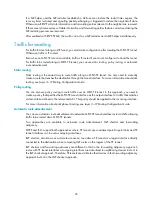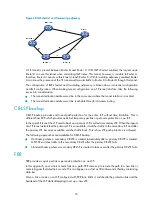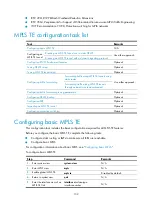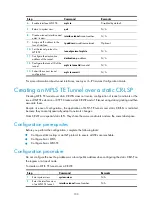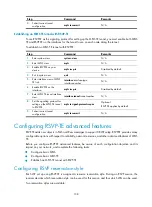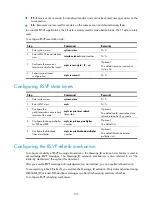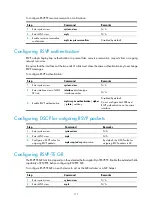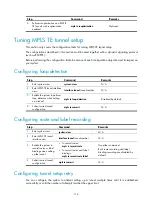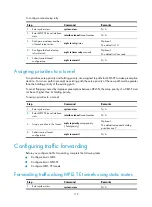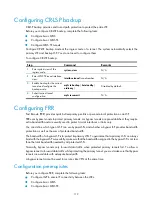
104
Step Command
Remarks
3.
Configure the tunnel to
use static CR-LSP.
mpls te signal-protocol static
N/A
4.
Submit the current tunnel
configuration.
mpls te commit
N/A
5.
Exit to system view.
quit
N/A
6.
Create a static CR-LSP on
your device depending
on its location in the
network.
•
At the ingress node:
static-cr-lsp ingress
tunnel-name
destination
dest-addr
nexthop
next-hop-addr
|
outgoing-interface
interface-type
interface-number
•
On a transit node:
static-cr-lsp
transit
tunnel-name
incoming-interface
interface-type
interface-number
in-label
in-label-value
nexthop
next-hop-addr
out-label
out-label-value
•
On the egress node:
static-cr-lsp egress
tunnel-name
incoming-interface
interface-type
interface-number
in-label
in-label-value
Use any of the commands
according to the location of the
device in the network.
The
tunnel-name
argument in the
static-cr-lsp ingress
command must
be the same as the tunnel interface
name created by the
interface
tunnel
command, including the
letter case. For example, if you
create a tunnel interface with the
interface tunnel
2
command, the
tunnel interface name is Tunnel2.
Then, the
tunnel-name
in the
static-cr-lsp ingress
command must
be in the form of Tunnel2—not
tunnel2 or TUNNEL2. Otherwise,
the tunnel cannot be established on
the ingress node. This restriction
however does not apply to transit
or egress nodes.
Creating an MPLS TE tunnel with a dynamic
signaling protocol
Dynamic signaling protocol can adapt the path of a TE tunnel to network changes and implement
redundancy, FRR, and other advanced features.
The following describes how to create an MPLS TE tunnel with a dynamic signaling protocol:
•
Configure MPLS TE properties for links and advertise them through IGP TE extension to form a TEDB.
To form a TEDB, you must configure the IGP TE extension for the nodes on the network to send TE
LSAs. If the IGP TE extension is not configured, the CR-LSP is created based on IGP routing rather
than computed by CSPF.
•
Configure tunnel constraints.
•
Use the CSPF algorithm to calculate a preferred path based on the TEDB and tunnel constraints.
•
Establish the path by using the signaling protocol RSVP-TE.
Configuration prerequisites
Before you perform the configuration, complete the following tasks:
•
Configure static routing or an IGP protocol to make sure all LSRs can reach each other.
•
Configure basic MPLS.









